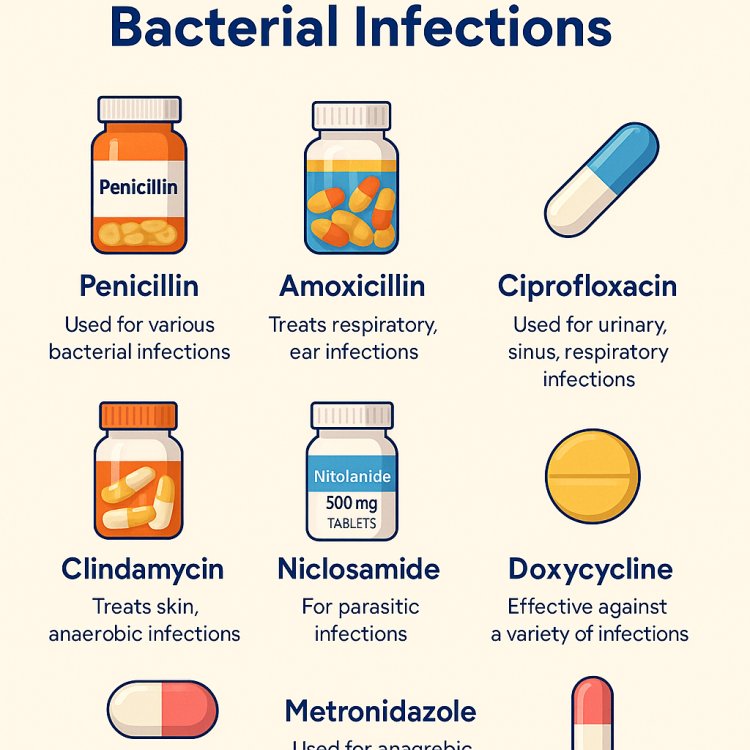Top Antibiotics for Combatting Bacterial Infections
Bacterial infections are common and can range from mild to life-threatening. Fortunately, there are several effective antibiotics available to treat bacterial infections.

Bacterial infections are common and can range from mild to life-threatening. Fortunately, there are several effective antibiotics available to treat bacterial infections. Choosing the right one depends on the type of bacteria causing the infection, the site of infection, and the patient’s medical history. In this article, we’ll explore some of the top antibiotics for treating bacterial infections, with a focus on buy niclosamide online, an important medication used to treat parasitic infections that may accompany bacterial infections.
1. Penicillin: The Classic Antibiotic
Penicillin, discovered in 1928, is still widely used today to treat various bacterial infections. It works by interfering with the bacteria's ability to form cell walls, causing them to rupture and die. Penicillin is effective against common infections like strep throat, pneumonia, and skin infections. It is often the first-line treatment for infections caused by Gram-positive bacteria.
2. Amoxicillin: A Broader Spectrum
Amoxicillin is a derivative of penicillin and has a broader spectrum of action. It’s used to treat ear infections, sinus infections, urinary tract infections (UTIs), and respiratory tract infections. Its ability to combat both Gram-positive and Gram-negative bacteria makes it a versatile choice for many bacterial infections.
3. Azithromycin: A Popular Macrolide Antibiotic
Azithromycin, a macrolide antibiotic, works by preventing bacteria from producing proteins necessary for their growth. It's commonly used to treat respiratory infections like bronchitis and pneumonia, as well as sexually transmitted infections (STIs) like chlamydia and gonorrhea. It has a long half-life, which allows for shorter treatment durations.
4. Ciprofloxacin: A Powerful Fluoroquinolone
Ciprofloxacin is a fluoroquinolone antibiotic, which means it targets the bacteria's DNA and prevents replication. It's commonly used to treat UTIs, sinus infections, respiratory infections, and gastrointestinal infections. Ciprofloxacin is particularly effective against Gram-negative bacteria and is often used when other antibiotics fail or when the bacteria are resistant.
5. Clindamycin: Effective Against Anaerobic Bacteria
Clindamycin is an antibiotic that works by inhibiting bacterial protein synthesis, thus preventing bacteria from growing. It’s commonly used for treating infections caused by anaerobic bacteria, which thrive in low-oxygen environments. Clindamycin is often prescribed for abscesses, skin infections, and pelvic inflammatory disease (PID).
6. Niclosamide: Treating Parasitic Infections with an Antibiotic-Like Effect
While primarily known for treating tapeworm infestations, Niclosamide also has applications in combating certain parasitic infections that may accompany bacterial infections. Available as a 500 mg tablet, it disrupts the ability of the parasite to absorb nutrients, leading to its eventual death. Though not a standard antibiotic for bacterial infections, it’s important in treating mixed infections that involve both parasites and bacteria.
Niclosamide is used in certain cases of intestinal infections caused by tapeworms and can help clear infections in both humans and animals. If you're looking to buy Niclosamide online, it's essential to consult a healthcare provider to ensure it's the right treatment for your specific condition.
7. Doxycycline: An Effective Tetracycline Antibiotic
Doxycycline is a broad-spectrum antibiotic that can treat a wide variety of bacterial infections, including chlamydia, Lyme disease, acne, and malaria. It works by preventing bacterial growth, making it effective in treating both Gram-positive and Gram-negative bacteria. Doxycycline is also used for its anti-inflammatory effects in diseases like rosacea.
8. Metronidazole: A Key Drug for Anaerobic Infections
Metronidazole is an antibiotic commonly used for anaerobic bacterial infections and parasitic infections, including trichomoniasis and giardiasis. It works by disrupting the DNA of the bacteria and parasites, preventing them from multiplying. Metronidazole is frequently used to treat infections in the gastrointestinal tract and vaginal infections.
9. Trimethoprim-Sulfamethoxazole: A Dual-Action Antibiotic
This combination drug is used to treat a wide range of infections, including UTIs, pneumonia, and bronchitis. Trimethoprim and sulfamethoxazole work together to prevent bacteria from producing folic acid, an essential nutrient for bacterial growth. This dual-action antibiotic is often effective in treating both Gram-positive and Gram-negative bacteria.
Conclusion
Choosing the right antibiotic for bacterial infections is crucial in ensuring effective treatment and minimizing resistance. Niclosamide, although primarily used for parasitic infections, can also play an essential role in treating mixed infections involving bacteria and parasites. Always consult with a healthcare provider before starting any antibiotic to ensure it’s appropriate for your infection type.
What's Your Reaction?















.jpg)
.jpg)


